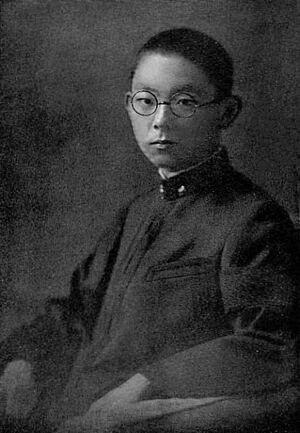Higashifushimi Kunihide facts for kids
Quick facts for kids
Count
Higashifushimi Kunihide
|
|
|---|---|
| 東伏見慈洽 | |

Prince Higashifushimi Kunihide, circa 1920s
|
|
| Born | 16 May 1910 |
| Died | 1 January 2014 (aged 103) |
| Other names | Kuni Kunihide Higashifushimi Jigō |
| Citizenship | Japan |
| Occupation | Buddhist monk |
| Title | Count (until 1947) |
| Spouse(s) |
Yasuko Kamei
(died 2009) |
| Children | 4, including Jiko Higashifushimi |
| Parent(s) | Kuni Kuniyoshi Shimazu Chikako |
| Relatives | Prince Higashifushimi Yorihito (great uncle) Empress Kōjun (sister) Emperor Shōwa (brother-in-law) Emperor Emeritus Akihito (nephew) |
Count Higashifushimi Kunihide (born May 16, 1910 – died January 1, 2014) was an important person in Japan. He was a Buddhist monk and the last head of the Higashifushimi family line. This family was once part of the Imperial House of Japan, which is the family of the Emperor.
He was the youngest brother of Empress Kōjun, who was the wife of Emperor Shōwa. This also made him the uncle of Emperor Emeritus Akihito. If he had stayed an Imperial Prince, he would have been the longest-living member of the Imperial family, living to be 103 years old. His special Buddhist name was Jigō.
Contents
His Early Life
Higashifushimi Kunihide was born as Prince Kuni Kunihide. He was the youngest child of Prince Kuniyoshi Kuni and Shimazu Chikako.
His great-uncle, Prince Higashifushimi Yorihito, led another branch of the Imperial family. This branch had no children to continue its name. So, in 1919, young Prince Kunihide was given to his great-uncle and his wife. This helped to keep the Higashifushimi family name going.
Becoming a Count
When he turned 20 in 1930, he became a member of the House of Peers. This was a part of Japan's government at the time.
However, the Emperor, who was his cousin and brother-in-law, asked him to leave the Imperial family. This was so he could officially take over the Higashifushimi name. After leaving the Imperial family, he was given the title of Count Higashifushimi. He also received a high honor called the Grand Cordon of the Order of the Paulownia Flowers. He kept the title of Count until 1947. At that time, many noble titles and branches of the Imperial family lost their special status.
Life as a Monk and Scholar
Higashifushimi Kunihide studied history at Kyoto Imperial University. After graduating, he taught there until 1952.
In 1952, he became a Buddhist priest. He took his vows at the Zenkō-ji temple in Nagano. The next year, he became the head priest, or abbot, of the Tendai Buddhist Shōren'in Temple in Kyoto. This is when he took his Buddhist name, Jigō.
His Work and Later Years
He continued his studies and earned a PhD in Asuka period art from Kyoto University in 1956. In 1985, he became the chairman of the Kyoto Association of Buddhist Temples. He held this important position until he passed away.
As chairman, he spoke out against a fee that the city of Kyoto wanted to charge people visiting temples. He believed this fee was wrong because it went against the idea of religious freedom. Because of his efforts, the fee was removed.
In 2004, he passed his role as abbot of Shōren'in to his second son, Jiko Higashifushimi. He then became the emeritus (retired) abbot. His wife, Yasuko, passed away in 2009. Higashifushimi Kunihide himself passed away on January 1, 2014, at the age of 103. He was known for being the longest-living member of the Imperial House of Japan.
See also
- List of centenarians (royalty and nobility)

